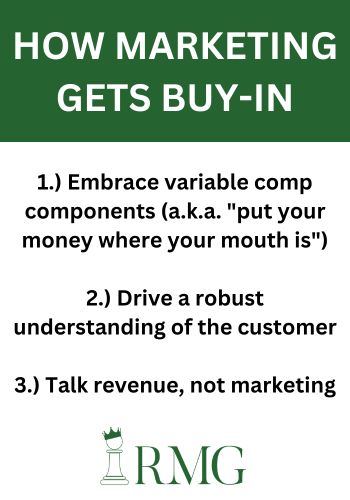Picture this: you’re in a meeting with other members of the executive leadership team at your company. The CFO is addressing the room, and then she looks right at you and asks “how did marketing impact our revenue number this quarter?”
What runs through your mind?
For me? It’s happiness.
Because marketing is clearly seen as a revenue contributor by the Chief Financial Officer. That’s an awesome company to work for!
And yet … this doesn’t happen nearly as often as it should.
Let’s start with a definition:
What is revenue marketing?
Others define it as “marketing focusing on revenue” or “working with sales more cohesively.” That’s not quite it.
Revenue marketing doesn’t just drive greater revenue. It evokes a cultural change within a given organization – moving marketing into a role as a crucial component of the company’s growth.
In any revenue-related discussions focused on growth, other departments – from sales to IT to finance – want to bring marketing into the discussion because they’re seen as strategic partners.
Now, this occurs because marketing consistently demonstrates revenue impact – more on that in a moment – but just showing revenue impact doesn’t change minds alone! There’s also education and cross-functional buy-in to what marketing is doing.
So, the next question becomes:
How does marketing get cross-functional buy-in?
Three ways:

Put your money where your mouth is.
Marketing demands respect and equal standing in the company compared to other departments. They should!
But your compensation and targets should back it up.
Ask these questions to identify if there’s a gap:
- Is marketing held to a number, or at least as part of one?
- Do marketing team members have a variable compensation component of their pay tied to revenue performance?
- Are marketing numbers different from sales numbers? If so, how do those numbers work together?
- Is there a component of customer retention that falls into marketing’s purview?
Drive a more robust understanding of the customer.
Gartner research shows B2B buyers are 80% or more through their buying journey before sales knows of them.
This positions marketing, with its ability to build influence within the market, as a unique driving force that knows the customer better than anyone else.
How?
First, it’s marketing’s job to know the customer better than potentially anyone else (customer success being the exception). If a buyer is ⅘ of the way through their decision-making process before sales gets involved, marketing has a fantastic opportunity to be the driving force for customer centricity.
Marketing’s also uniquely positioned to influence both net-new and existing customers. After all, you can actively market to both – one with the goal of conversion and the other with retention and expansion.
One team impacts two areas that drive your company’s growth.
And so, who better to lead transformative work to embrace and impress your company’s customers?
Talk revenue, not marketing.
You need one dashboard with the vital revenue-focused metrics and any supporting reporting showing how marketing impacts these key metrics.
Some reports you might want to include:
- A marketing activities report showing how many logged activities marketing has on crucial accounts
- A marketing-sourced revenue number
- Account metrics showing retention numbers and revenue from existing vs. new (for B2B companies)
- Depending on how pipeline is measured, you may want to show items such as demos, SQLs, booked calls, etc. – i.e. any sales-focused conversion point in your buyer’s journey.
Each conversation marketing has ties to these reports and involves a narrative of how what it’s doing links to this.
Are you (or your team) working on podcast appearances, content, SEO, LinkedIn Ads, and more? Great!
Please don’t talk about those except in the context of how they impact the numbers on the dashboard.
That’s what it means to be a revenue marketer: Consistently tying your work to business outcomes and framing your overall strategy and tactics around those bottom-line metrics. It takes a storytelling ability, but great marketers possess this already.
What comes after revenue marketing?
Revenue marketing is a worthy goal where marketing is respected across the business and is on equal terms with other teams (such as sales). Goals are aligned and focused on the metrics the C-suite cares deeply about.
But what comes next?
That’s a question I once asked Dr. Debbie Qaqish, the person often credited with bringing the term revenue marketing … to market. She’s written two books, including Rise of the Revenue Marketer.
Her response when we spoke (caveat: I used to work with her) was one of deep thinking. Considering her incredible mind, I’m very much looking forward to what she comes up with!
But allow me a chance to take a pass at a bold prediction:
We’ll see more CMOs become CEOs in the next 10-20 years.
I’ll call this “revenue leadership” because I’m a marketer who likes trying to name things. (You can let me know your preferred terminology over on LinkedIn or laugh at my vain attempt here)
The reasons:
- Buyers will continue to avoid sales, and eventually, the C-suite will realize that investing more heavily in marketing will be what yields the greatest fruit.
- The best CMOs already speak multiple “languages” within the business – those of IT, Finance, HR, Sales, Customer Success, and more – and who better to become a CEO than someone who can navigate most seamlessly across many teams?
- People buy from people, and many companies have yet to unlock how to “humanize” their brand – but a savvy CMO already knows how to do this and create a more likable company that people want to keep doing business with.
- CMOs continue to embrace more potent marketing modeling mixes, and that marketing area is begging to gain more heavy investment – which I think it’ll get.
Now, CMOs who don’t have a firm grasp of the underlying financials continue to fail, and I’d say more so than usual. So while the oft-cited “average tenure of a CMO” stat will continue to highlight the short-lived nature of the role for negative reasons, more positive ones will also appear as some CMOs get promoted.
The journey to revenue marketing isn’t easy. But it’s worth it for businesses serious about enabling the sustainable growth they’re looking for.
Look to your marketing teams. They’re ready to lead – and have the metrics to prove it.
We help marketing teams evolve. Grab a time to talk more here or learn how we help B2B marketers and SaaS marketers.


Comments are closed